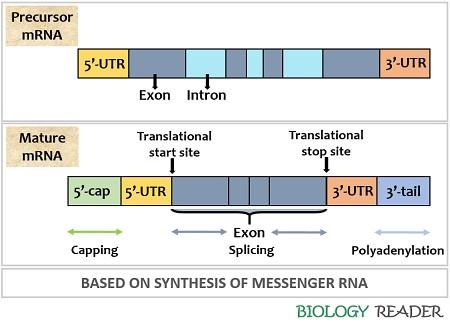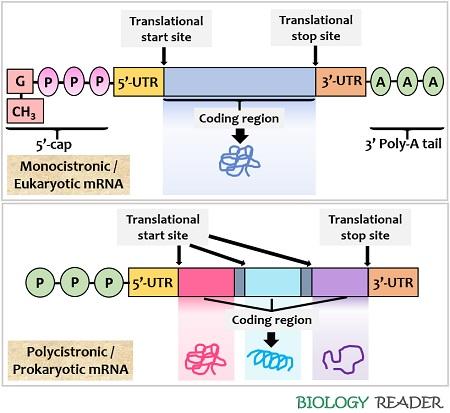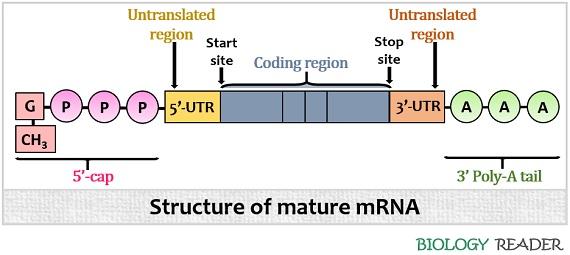Messenger RNA abbreviated as “m-RNA”, and it contains specific codons encoding particular amino acids, which later synthesize proteins (as amino acids are the monomer units of proteins).
Protein is an element that is required to develop life forms, so a cell must translate specific proteins. Therefore, for proper growth and cell development, gene translation or protein synthesis is necessary.
Messenger RNA is a gene product formed as a result of DNA transcription. It functions as a “Guide” that contains all the information to start the process of translation. In this context, we will discuss the definition, types, structure and functions of the mRNA, and its synthesis pathway.
Content: Messenger RNA
Definition of Messenger RNA
Messenger RNA refers to an RNA sub-type that carries the specific codons corresponding to the DNA template and helps in the sequencing of amino acids to build various proteins by associating with the transfer RNA and ribosome.
Messenger RNA exists as a short, single-stranded molecule that comprises a sugar-phosphate backbone. Therefore, m-RNA serves as a DNA transcript that contains the information for the gene translation into protein. The formation of prokaryotic m-RNA is less complicated than the eukaryotic m-RNA.
Synthesis of m-RNA
In prokaryotes, messenger RNA synthesis occurs solely inside the cytoplasm as they lack a true nucleus. In eukaryotes, messenger RNA synthesis occurs inside the nucleus by using the nucleotide sequence of a template DNA strand.
Therefore, the template DNA transcribes the messenger RNA through a biological process known as “Transcription”. The RNA polymerase-II initiates mRNA transcription using a substrate (nucleotide triphosphate) from the template DNA strand.
Types of mRNA
Based on mRNA synthesis, the DNA transcribes into pre- mRNA and later transforms into a mature mRNA.

Pre- mRNA
It is an acronym for the term “Precursor mRNA”. Pre- mRNA refers to the primary transcript or immature mRNA, which belongs to the group of heterogeneous nuclear mRNA. Precursor mRNA comprises both coding exon sequences and non-coding intron sequences. During its processing, the unwanted sequences or introns splices out of the mRNA strand in two ways:
- Splicing by the RNA’s catalytic activity.
- Splicing by a multiprotein structure or spliceosome.
Mature mRNA
Further modifications in the pre- mRNA convert it into a mature mRNA transcript. Therefore, mature mRNA is derived after the maturation of pre- mRNA. Unlike pre- mRNA, it lacks introns.
For the translation of amino acids into proteins, 5’ capping and later tailing at the 3’ prime occurs in the mature mRNA. After processing, the mature mRNA exits the nucleus and enters cytosol.
Then, the t-RNA plus ribosome decodes the information carried by mRNA to build proteins accordingly. Based on protein expression, the mRNA is categorized into the following types:

- Monocistronic mRNA: It is a kind of mRNA common in eukaryotes, which carries the exon sequences coding for a single protein.
- Bicistronic mRNA: It is a type of mRNA carrying exon sequences that encode two proteins.
- Polycistronic mRNA: It is a kind of mRNA common in bacteria and bacteriophages, which carries the exon sequences that code for multiple proteins.
Structure of Messenger RNA
The structure of mature mRNA includes the following elements:

Coding sequences
The coding sequences of mature mRNA contains triplet codons. In eukaryotes, the triplet codons code for specific amino acids and translate them into a single protein. Oppositely, the triplet codons in prokaryotes translate a gene into multiple proteins through the assistance of tRNA and ribosome.
The coding region begins with a “Start codon” (AUG) and ends with the “Termination codon” (UAA, UAG and UGA). Internal base pairs maintain the coding region. The coding region also functions as a regulating sequence, exonic splicing enhancer and inhibitors in the precursor mRNA.
Untranslated region
There are two untranslated regions in mature mRNA, one at 5’ prime and the other at 3’ prime. The 5’ untranslated region is present in between the 5’ cap and start codon. Conversely, 3’ untranslated region is present in between the stop codon and 3’ tail. The untranslated region is transcribed within the coding part. It performs the following functions:
- Stability of mRNA: Both 5’ and 3’ untranslated regions regulate mRNA stability due to varying affinity for ribonucleases and ancillary proteins that can promote or inhibit RNA degradation.
- Translational efficiency: 3’ or 5’ UTR may influence the transitional efficiency by controlling the ribosome’s ability to bind with the mRNA.
- Localization of mRNA: This is regulated by 3’ UTR that contain sequences, which allow the transcript to be localized to the region for translation.
- The untranslated region also contains some elements that regulate the mRNA:
- SECIs element: It targets the proteins to bind.
- Riboswitches: It directly binds the small molecules.
Poly (A) tail
A mature mRNA comprises a polyadenylated tail (up to 150-250 adenine bases) after the 3’ untranslated region. The Poly (A) tail performs the following functions in the mature mRNA:
- 3′-tailing in eukaryotic mRNA helps in the transportation of mRNA residing within the nucleus into the cytoplasm.
- The 3′ poly-A tailing protects the 3′-end of mature mRNA from degenerating.
5’-cap
A mature mRNA also comprises a 5’-cap before the 5’ untranslated region. The 7-methylguanosine cap associates with the 5’ end via 5’-5’ phosphate linkage, and it performs the following functions in mature mRNA:
- The 5′-mRNA capping also protects the 5′-end of mature mRNA against degeneration.
- 5′-capping in mRNA also directs the binding of the ribosomes during protein synthesis.
Functions of Messenger RNA
The messenger RNA performs a functional role in the process of gene expression by participating in the following tasks:
- An mRNA contains the source of genetic information from the template DNA that directs the amino acid formation.
- It also contains multiple regulatory regions that determine the rate and flow of translation.
- An mRNA contains information on how to connect the amino acids into a peptide chain to form the proteins.
Conclusion
Therefore, the enzymatic activity of RNA polymerase on the DNA strand forms the mRNA (a sub-type of RNA). The messenger RNA transcription occurs from the 5′-3′ end, and its further processing occurs before translation.
The transfer RNA in the cytosol possesses one specific anticodon arm that decodes the coding sequence of mRNA. After appropriate sequencing of amino acids, the transfer RNA loads the amino acids onto the ribosome, which results in protein synthesis.